|
[ Back ] [ Home ] [ Up ] [ Next ]
|
*
* Click
pictures to enlarge; close out of that window to return to this page * *
 Unusual flowering tree
Unusual flowering tree |
|

Deshaies

Ripening bananas "marked" and protected from birds

The Saints, behind Pain du Sucre
Nat'l Park Rainforest



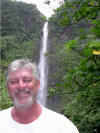
|
GUADELOUPE - MAY 6, 2004:
We had a good 7-hour sail from Antigua (hard to leave after such an exciting
time there, but ready for some R&R) south to the west coast of Guadeloupe,
having previously visited Guadeloupe in
December 2003. We arrived in Deshaies, having
been here before only by rental car. Deshaies is a small, but charming
(naturally, it's French) town with the main street (and sidewalks under
re-construction) stretching around the harbor. A great find was fresh
hot baguettes made over a wood-burning oven - they had a wonderful smoky
aroma and taste - and were great for breakfast (or anytime!) with creamy
French butter. We hiked up to the attractive botanical gardens,
previously visited and enjoyed. We rented a car and this time explored the southern
half of the west "butterfly wing", driving along the coast line and then up
into the large rain forest. The rain forest is a national park and is
impressively done with beautiful stone and wood walkways, steps and bridges
for the first part . . . then parts become more primitive. We did slop
through mud where there had been a washout. There are 3 very large
waterfalls (supposedly the largest in the eastern Caribbean) with hot
springs at the base of the one we hiked to.
After a few days, we headed south to
previously visited (in
December 2003)
The Saintes. Intending
to stay only a few days before heading due east to Marie Galante, weather
turned unsettled and squally at times with
over a week of steady rain, the most rain we've seen since cruising, filling the
dinghy 1/2 full one night (now we remember to take the plug out). Good
news, we got a well-needed boat wash - over and over again. For
cruisers that collect their water it's been a blessing. Before the rains, we took
the dinghy to the pretty little beach behind Pain du Sucre, took off the
outboard, flipped it over and cleaned the barnacles and other growth off the fiberglass
bottom, and cleaned the rest of it. We also went to some of the other beaches and hiked
up to Fort Napoleon again - yeh, seen one fort you've seen them all, but, this is
one of the better forts we've seen, with a breathtaking panoramic view and
easygoing 5 foot iguanas following us around. The main town of Bourg
des Saintes isn't nearly as charming as before, as they are completely
tearing out the ferry dock; we're assuming it will be rebuilt. As a
result, "tourist" traffic is thankfully much lighter in town.
More stuff on the French. It
has been obvious to us how the French islands have a prosperous mother
country to support them, unlike poorer islands that are self-sufficient:
St. Barts is shutting down their small airport (thus virtually the island)
this fall to completely redo the runway; Deshaies is redoing sidewalks and
streets; Guadeloupe's national forest was well developed and maintained; and
The Saints is completely redoing the ferry dock, Martinique has put in new
cruise ship dockage in Fort de France. On a different note,
we made several attempts in 2 towns to clear into customs and immigration,
always finding them closed (suppose posted hours are only a guideline). OK, if
they don't care we don't care. After flying the yellow quarantine flag
for a week, we were successful clearing in in The Saints. (Of all
islands, the French officials really don't care about this kind of stuff and
they do NOT collect any fees, so cruisers love French islands.) On the
other hand, as I have mentioned before, French cruisers present
another problem. They don't care either. The French are
notorious for anchoring too close: If they're not banging into you, then
it's not a problem. Point at hand: In Deshaies, we woke one
morning to someone softly yelling "ARGO". We thought a cruiser was
dinghying by to say "hi". Steve's "OH, SHIT!" gave me an indication
that wasn't the case, as we both flew topside (buck naked) to fend off a
French boat parallel and literally two fingers from our port side. I threw Steve some
bottoms (certain things need to be protected first and foremost) and he runs
forward to pull up some anchor chain. OK, he did get a little
distracted by the topless French babe fending off. Back to reality, I
(now somewhat clothed) start up our engine just in case. The French
guy gently says to me in English "It's no problem. It's no problem.". I
differ and tell them so, but they just shrug their shoulders, like "What's
got her panties in a bunch?". Since then, we have consulted Kathy
Parson's new French For Cruisers book, where she aptly devotes
four pages to these exact situations, having phrases for (page 162) "You
are too close" and "You anchored on top of my anchor". We had to use
her phrase "Put out more chain" in The Saints where a French boat
irresponsibly anchored WAY TOO CLOSE to us. It is internationally
accepted that the French have a whole different anchoring ethic from the
rest of the world. Enough said . . . for now!
OK, now on to the Texans.
Americans are pretty friendly people among the cruising community all in
all. Texans are even friendlier. And we fly our
internationally-recognized (seriously) Texas state flag proudly (thank you Mike
and Diane, and brother Ray for your contributions). That in itself creates a unique bond
in the cruising community, as you always have to meet the Texans in the
anchorage. You would be surprised how many Texans are out
cruising, probably second only to Floridians. [Factoid: Texas is supposedly the only state flag that
can be flown at the same level as the U.S. National flag. Has
something to do with raising the Texas flag at the Alamo. ]
|

Old sugar mill
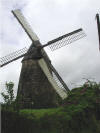
Windmill, operational ?

Squeezing juice out of sugar cane

Yumm, "rum" in outdoor vats during processing |
 Anchorage at St. Louis, Marie Galante
Anchorage at St. Louis, Marie Galante
After waiting for the squally weather
to lighten up a bit, 8 days later we set out for the rainy 16-mile trip to
MARIE-GALANTE, an island that looks like a lush green pancake - round
(8x9 miles), flat and covered with sugar cane crops, thick woods and palm
trees along the coasts. It is part of Guadeloupe and being "out of the
way" doesn't attract much traffic except for visitors from the mainland via
ferry. Sugar cane is the major industry here and ox-drawn carts are
still used to haul sugar cane. There are many windmills in various
states of disrepair at old sugar mills. One windmill is still
supposedly operational on a daily basis, but was closed when we went there.
We also missed the large sugar mill here. We toured the island by
rental car on an overcast and rainy Saturday, which also happened to be a
holiday weekend for Guadeloupe, so our bad timing may have to been to blame.
Being a small island, we pretty much saw everything in less than a day,
including some pretty beaches,
and a huge sink hole on the north coast. We
anchored off St. Louis, the island's "main"
yacht anchorage - along with 5 other boats - in shallow, light emerald
green water and a long, palm fringed white beach. St. Louis is a
typical, small French town - but with an overabundance of scooter/car rental
places. |

NW coast

Huge sink hole
(100' up)

Sugar cane fields

Capesterre beach |
|
DOMINICA - MAY 24: (pronounced doe-meh-nee'-ka)
We anchored by
 Portsmouth
in Prince Rupert Bay. This independent,
English-speaking island is very poor with high unemployment, although we
noticed many improvements (in roads, business development, etc.) since we
were here by charter boat a dozen or so years ago. Dominica is a
volcanic island, thus has high rain forest covered mountains. It is
known as the island of 365 rivers, and I believe someone has actually counted them.
The rest is literally covered with fruit trees and vegetable crops - which
they export to the other islands - making this one of the
most lush islands in the E. Caribbean. Unemployment may be high, but
no one will starve to death here. Portsmouth
in Prince Rupert Bay. This independent,
English-speaking island is very poor with high unemployment, although we
noticed many improvements (in roads, business development, etc.) since we
were here by charter boat a dozen or so years ago. Dominica is a
volcanic island, thus has high rain forest covered mountains. It is
known as the island of 365 rivers, and I believe someone has actually counted them.
The rest is literally covered with fruit trees and vegetable crops - which
they export to the other islands - making this one of the
most lush islands in the E. Caribbean. Unemployment may be high, but
no one will starve to death here.
The highlight here is the brand new Rain Forest Aerial Tram (www.rainforestrams.com),
built by some U.S. based wealthy Italian investor with a keen eye for
preserving the environment and on the
 aesthetics.
An open
tram car seats 8 plus the guide. We (6 cruisers) were the only ones in
the park so that added to our magical experience. The tram glides slowly and
silently under the rainforest canopy for a 30 minute ride up aesthetics.
An open
tram car seats 8 plus the guide. We (6 cruisers) were the only ones in
the park so that added to our magical experience. The tram glides slowly and
silently under the rainforest canopy for a 30 minute ride up
 to
the top, with branches and tree trunks literally brushing by our legs (you
have to be careful when sticking your head out to take a picture so you
don't get it whacked by a tree trunk). At the top, we got off and
hiked down a ways getting a close up lesson on the various plant life here, and crossed a long suspension bridge high over a to
the top, with branches and tree trunks literally brushing by our legs (you
have to be careful when sticking your head out to take a picture so you
don't get it whacked by a tree trunk). At the top, we got off and
hiked down a ways getting a close up lesson on the various plant life here, and crossed a long suspension bridge high over a
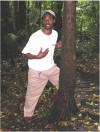 river
gorge.
Getting back on the tram, another 30 minute trip down the mountain, this time higher up
just at the canopy level. Our guide, Julian (left, explaining about
the red roots), was very knowledgeable and did an excellent job of educating
us on many aspects of this rainforest. The whole attraction was very
impressive and tastefully done, and while it was not cheap, we all agreed it
was worth every penny. We hope they are able to sustain enough
business to keep it profitable, most business coming from the cruise ship
industry during high season. river
gorge.
Getting back on the tram, another 30 minute trip down the mountain, this time higher up
just at the canopy level. Our guide, Julian (left, explaining about
the red roots), was very knowledgeable and did an excellent job of educating
us on many aspects of this rainforest. The whole attraction was very
impressive and tastefully done, and while it was not cheap, we all agreed it
was worth every penny. We hope they are able to sustain enough
business to keep it profitable, most business coming from the cruise ship
industry during high season.
 We
also visited the Oceanographic Institute of Dominica We
also visited the Oceanographic Institute of Dominica
 where
they harvest corals, live rock, invertebrates, and fish from the nearby sea
and grow them for sale. Fresh sea water is circulated through the
sloping, interconnected tanks using gravity. (Picture on right - NOT a
pepperoni pizza!) where
they harvest corals, live rock, invertebrates, and fish from the nearby sea
and grow them for sale. Fresh sea water is circulated through the
sloping, interconnected tanks using gravity. (Picture on right - NOT a
pepperoni pizza!)
 We
returned (after a dozen years) to the Sisters Sea Lodge open air restaurant for a wonderful meal,
served "family style" on a gigantic banana leaf, with grilled fish,
plantains, local vegies and fruits. Excellent! We
returned (after a dozen years) to the Sisters Sea Lodge open air restaurant for a wonderful meal,
served "family style" on a gigantic banana leaf, with grilled fish,
plantains, local vegies and fruits. Excellent!
|

Dick & Jo (s/v Remedy), island guide Martin, Marcie
& Dave (s/v Godiva) snacking on local fruit

Rain Forest group: Dave, guides Julian & Martin, Dick, Jo,
Marcie

 |
|
ST. PIERRE
   
St. Pierre Town; Ruins; Theatre ruins; Ruins lit at night from ARGO |
MARTINIQUE - MAY 27: (Previously visited
June
2003.) We checked out 4 anchorages while in this French island.
St. Pierre was known as the Paris of the Caribbean when in 1902 the
Mt. Pelee volcano erupted wiping out it's entire population of 30,000, save
for 2 people, one who was imprisoned in a stone cell - he later went on to
join the circus as an attraction. The old ruins have been mostly kept intact with new
construction using the old walls. The "front" street ruins are lit up at
night and make for a magnificent view from our cockpit. There is a
great little museum that details this disaster. We also toured [another] rum
distillery and shopped the Saturday morning market for fresh produce and
flowers. We then anchored at Anse Mitan
(a resort area), and took the high speed ferry across the huge commercial
bay into Fort de France several times for shopping and sightseeing.
We also anchored at Grande Anse d'Arlet and
Ste. Anne near Le Marin. Unfortunately, Ste. Anne has lost some of
it's wonderful charm: That great pizza place we bragged about is now
disappointing due to change in ownership; thanks to a generous mother
country's financial support, a ridiculous overabundance of ordered buoys now
mark the huge beach areas, keeping boats at least 100 yards away from the
beautiful beach areas; and last but not least, Club Med has closed
indefinitely.
 |
 |
 |
 |
|
Grande Anse d'Arlet |
Art on walk to ... |
Petite Anse d'Arlet |
Anchorage at Ste. Anne |
|

"Micro" distillery (above), versus big modern distillery
(below)
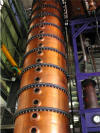 |

Rodney Bay to right, Lagoon in background

Marjorie & Richard (s/v North Stand, from
Austin) and guest Debra
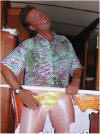
Richard: cute girlie-boy
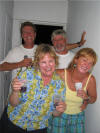
Locked in the bathroom at a Friday
night jump-up (do we look worried?); had to escape thru kitchen

Yes, island life can be hazardous to your health - people die this
way each year |
ST. LUCIA - JUNE 9: (Previously visited
June
2003.) After enduring weeks of rain, we pulled into the marina
at Rodney Bay, hooked up to shore power and turned on the A/C to
"dry" things out. Dockside convenience, a water faucet and cable TV
didn't hurt either. The last time we were at a marina was here a year
ago. We helped Dick (s/v Remedy) celebrate his birthday, when
Cecil (s/v Duet) flew his favorite band, the Honky Tonics, a
husband/wife band (keyboard, vocals / sax) in from Bequia. There was
great audience participation on the stage and dance floor for 4 hours.
Another night, a group of cruisers had an awesome Indian/Tandoori dinner at
Razmataz - it was truly one of the best meals since cruising. After getting our fill of
cable movies and sleeping under a blanket, we
reluctantly pulled out after a week and headed south to The Pitons.
The Pitons are 2 majestic and lush, pointy mountains
on the southwest coast of St. Lucia with an anchorage in between, and
the very pretty first-class but discreetly casual Hilton with its white
beach. This is one of the most awesome and scenic anchorages we have
ever been in - pictures, of course, can't begin to capture this.
The anchorage is a national park with a snorkel area, mooring balls, and a 2-night nominal
fee. We explored the area ashore taking a dip in the natural mineral
springs, wondering the unique botanical gardens/mineral baths, and visiting
the bubbling sulphur springs with spurts of steam (heated by the active but
dormant volcano) looking like something out of Road Warrior. Lunch was
at Ladera, another casual but classy resort perched spectacularly on the
ridge between the 2 Pitons with view of both (can't quite capture this with
the camera, either). This is the perfect blend of mountains and water.
|
THE PITONS |
 |
 |
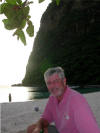 |
 |
| |
Lunch at Ladera, perched between Pitons; ARGO below |
|
|
We continue heading south to St. Vincent and The
Grenadines. Off the northwest coast of St. Vincent, we see our first
whale: It looks like a black shipping container shooting up out of the water.
After 3 or 4 breaches, it's huge fluked tail rises high in the air before
disappearing below.
|

Dick's birthday party: Can you tell the faking players from
the Honky Tonics?

Boat boy selling fruits & vegies

Boiling volcanic sulphur springs

Mineral baths

Jalousie Hilton at The Pitons
|
|
WALLILABOU
 
"Pirates of The Caribbean" set
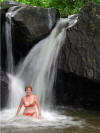
Morning dip

Leaving Wallilabou in rain; movie facades visible |
ST. VINCENT - JUNE 20: This is our first visit
to St. Vincent, which is a volcanic island and verdant much like St. Lucia.
Cruisers were avoiding it last year due to several incidences of theft and boardings.
Taking our usual precautions (like you do when living in Houston!) we made
sure other boats were in the anchorages we chose. We stayed one night
at the very tiny settlement of Wallilabou. It's claim to fame
is this is
where the movie "Pirates of the Caribbean" starring Johnny Depp was filmed. For the movie, a facade was added to the existing buildings;
the dock, gallows and additional buildings were built. All still
stand undisturbed today, although facades are starting to peel off.
It's interesting to look around. About the only other thing here is a
small restaurant/bar (with original models of the movie set) and a
customs/immigration office that was always closed. In
this anchorage, due to the depth, wind and current, we attached to a mooring ball
and tied the stern to the dock with the help of a boat boy. Boat boys were too many and too persistent, although this is now low season and we were told this was
nothing. A few obviously had been overindulging in home grown ganga,
part of the "security" problem. The next morning we hiked
around and went for an early morning
dip at the base of a small waterfall up the road, and then we were off.
We moved to the south coast and anchored at
Young Island Cut, a popular anchorage, next to Blue Lagoon (which is
too shallow for ARGO to enter). Again using local buses, we ventured
into Kingstown, the capital of St. Vincent, several times. Young Island is a small
private resort island with rooms and cottages nestled on the hillsides.
Lots of pathways meandering throughout the
property, with luxurious and labeled plantings all around, provided an
afternoon of hiking with pretty views. It's low season, so
these type places don't really care if you wonder through and buy a beer.
After experiencing laptop problems, and
communicating via onshore email with the supplier numerous times for
troubleshooting help, we decided to send it back to the States for repairs
(don't ask us to justify this decision), and did so from Kingstown by 2-day
FedEx. Steve then went into a funk due to email withdrawal, and
Deborah had to postpone working on the already-overdue website update.
We have become quite dependent on the computer for everything from email to
finances to navigation, and will buy a backup computer at some point [yippie, Deborah
will get her own!]. Lessons learned: Have a backup computer
onboard, carry all your software CDs with you for reinstalling, use
corrosion block on all connectors, and do backups regularly (which we had
done anyway).
We leave St. Vincent and head south to
The Grenadines . . .
|
YOUNG ISLAND

ARGO anchored at Young Island Cut
|
|
|
|
|
[ Back ] [ Home ] [ Up ] [ Next ]
[ Top of page ]
|
![]()